Another World is possible
Arna's Memorial
B'Tselem
Campagne Civile Internationale pour la Protection du Peuple Palestinien
Desert Peace
Electronic Initfada
Encyclopedia of the Palestine Problem
Free Gaza
Gaza Strip
Gush Shalom
Haaretz (israelische Zeitung)
If Americans Knew
Independant Jewish Voices
Indymedia Beirut
Indymedia Palästinien (c/o de)
International Solidarity Movement
Israelisch/jüdisch Friedensorganisationen
Jerusalem Forum
Jüdische Stimme für gerechten Frieden in Nahost
Machsom Watch: Israelis beobachten Übergriffe auf Palästinenser
Maps of Palestine
MIFTAH
OCHA
OCHA
Palestine News Agency
Palestines Prisoner Page
PASSIA
PCHR
Rachel Corrie Memorial
The Alternative News
Zeitfragen
Seither hat sich die Lage der Bevölkerung in Gaza nicht verbessert. Ob Waffenstillstand oder nicht, die Dörfer und Städte werden regelmäßig beschossen, aus Hubschraubern oder Flugzeugen, von Schiffen, aus Panzern. Meist die ganze Nacht durch. Die UNO berichtet, dass die Kinder in Gaza von diesem ständigen Beschuß extrem traumatisiert sind.
Jetzt wird Gaza vom israelischen Militär gezielt zerstört. Begründet werden die Angriffe auf zivile Einrichtungen mit der Hamasregierung im Gaza und den Qassamraketen. Vom Kräfteverhältnis ist das wie wenn ein starker Mann ein Kind erst ständig knufft und dann grün und blau schlägt, weil es ihm irgendwann auf die Zehen steigt. Na ja, so was soll vorkommen. Ich weiß nicht, ob wir dafür Verständnis haben müssen.
Lesen Sie den Bericht unten. Vielleicht verstehen Sie einiges besser. Suchen Sie selbst nach ähnlichen Quellen - oder bestellen Sie den Film, wenn Sie starke Nerven haben.
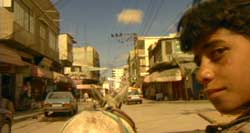 "GAZA STRIP was filmed during the
first four months of 2001, a period that covers the election of Israeli
prime minister Ariel Sharon and extends to the first major armed
incursion into "Area A" by the Israeli military. It was my first trip
to the Middle East; all of my previous international filmmaking
experience took place in Russia. The idea to make a documentary about
Palestinians inside the Gaza Strip was mainly a reaction to what I
perceived as a lack of good media coverage of that area: it was
difficult for me to find intimate material of the Palestinian struggle
in the mainstream US media. More than anything, it was a desire to
satisfy my own curiosity about what was really taking place inside the
Occupied Territories that induced me to take matters into my own hands
and produce the project.
"GAZA STRIP was filmed during the
first four months of 2001, a period that covers the election of Israeli
prime minister Ariel Sharon and extends to the first major armed
incursion into "Area A" by the Israeli military. It was my first trip
to the Middle East; all of my previous international filmmaking
experience took place in Russia. The idea to make a documentary about
Palestinians inside the Gaza Strip was mainly a reaction to what I
perceived as a lack of good media coverage of that area: it was
difficult for me to find intimate material of the Palestinian struggle
in the mainstream US media. More than anything, it was a desire to
satisfy my own curiosity about what was really taking place inside the
Occupied Territories that induced me to take matters into my own hands
and produce the project. 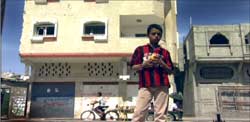 At first it was
daunting,
to say the least. I didn't speak Arabic, I had no contacts on the
ground. I had never even met a Palestinian in my life. The current
intifada had been underway for five months and hundreds of people --
mostly Palestinian civilians -- had already been killed in the
violence. After a number of dire warnings from Israelis about the
likelihood of my being attacked by angry Palestinian mobs, it was with
much trepidation that I crossed alone through the Erez Crossing
checkpoint into the Gaza Strip one rainy day in January.
At first it was
daunting,
to say the least. I didn't speak Arabic, I had no contacts on the
ground. I had never even met a Palestinian in my life. The current
intifada had been underway for five months and hundreds of people --
mostly Palestinian civilians -- had already been killed in the
violence. After a number of dire warnings from Israelis about the
likelihood of my being attacked by angry Palestinian mobs, it was with
much trepidation that I crossed alone through the Erez Crossing
checkpoint into the Gaza Strip one rainy day in January. 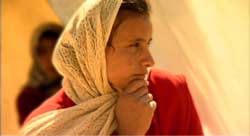 To my great relief,
the
Palestinians in the Gaza Strip turned out to be people like everyone
else. It is the situation they find themselves in that is
extraordinary: The Gaza Strip is essentially an open-air prison for
Palestinian refugees, guarded on all sides by the Israeli military.
Barely 28 miles long and 4 miles wide, it contains more than 1,200,000
Palestinians -- over one third of them living in squalid refugee camps
built in 1948 to hold the people forced out of their homes by the
creation of modern-day Israel. It is one of the most densely populated
places on the planet. Nobody can pass through its borders without the
permission of the Israeli soldiers. Like the West Bank, the Gaza Strip
has been under Israeli military occupation since 1967. Most people
living in the Gaza Strip have never known a single day of real freedom.
To my great relief,
the
Palestinians in the Gaza Strip turned out to be people like everyone
else. It is the situation they find themselves in that is
extraordinary: The Gaza Strip is essentially an open-air prison for
Palestinian refugees, guarded on all sides by the Israeli military.
Barely 28 miles long and 4 miles wide, it contains more than 1,200,000
Palestinians -- over one third of them living in squalid refugee camps
built in 1948 to hold the people forced out of their homes by the
creation of modern-day Israel. It is one of the most densely populated
places on the planet. Nobody can pass through its borders without the
permission of the Israeli soldiers. Like the West Bank, the Gaza Strip
has been under Israeli military occupation since 1967. Most people
living in the Gaza Strip have never known a single day of real freedom.
My plan was to find a main character to follow -- probably a stone-throwing kid or an ambulance driver -- who would be able to give a narration and framework to the events taking place. I knew from the start that I didn't want to write a narration for the film; I wanted the characters I filmed to speak for themselves and tell their own stories.
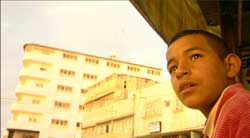 I found the film's
principal
voice in the person of Mohammed Hejazi,
a 13-year-old paper boy in Gaza City. He was the first person I filmed
inside the Gaza Strip. One afternoon early in my stay I walked out to
Karni Crossing, a place in east Gaza where many children have been
killed and wounded by Israeli soldiers while throwing stones at tanks,
and the kids there pushed him in front of the camera as their
spokesperson. It was no accident: Mohammed could talk the ears off a
donkey, and he has a great deal to say. I followed him for several
weeks, recording hours of interviews and verite material.
I found the film's
principal
voice in the person of Mohammed Hejazi,
a 13-year-old paper boy in Gaza City. He was the first person I filmed
inside the Gaza Strip. One afternoon early in my stay I walked out to
Karni Crossing, a place in east Gaza where many children have been
killed and wounded by Israeli soldiers while throwing stones at tanks,
and the kids there pushed him in front of the camera as their
spokesperson. It was no accident: Mohammed could talk the ears off a
donkey, and he has a great deal to say. I followed him for several
weeks, recording hours of interviews and verite material. 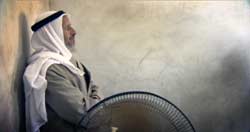 The situation in the
Gaza
Strip worsened noticeably during my stay. Sharon was elected prime
minister and immediately began a campaign to demolish the
infrastructure of the Palestinian Authority. I eventually branched out
from Gaza City and moved to the refugee camp of Khan Younis in the
southern part of the Gaza Strip, where things were made particularly
tense by the proximity of a large Jewish settlement that virtually
surrounds the western edge of the camp. Khan Younis came under constant
attack from the Israeli military while I lived there -- particularly at
night. The Israeli machine-gunners would usually start around 10 pm,
firing into the city. Most of the time it seemed as if the IDF soldiers
were shooting out of boredom. They would tap out little tunes with
their armor-piercing ammunition, like fans clapping at a hockey match.
Most nights, the bombardment would last until morning. Families living
on the perimeter of the camp gradually evacuated their homes and moved
in with relatives. After about a week in Khan Younis, I became
accustomed to the Israeli gunfire and tank shells. I moved my bed to
the balcony of the apartment I shared with two French journalists,
letting the sound of the machine-guns lull me to sleep. A quiet
night was a fitful night.
The situation in the
Gaza
Strip worsened noticeably during my stay. Sharon was elected prime
minister and immediately began a campaign to demolish the
infrastructure of the Palestinian Authority. I eventually branched out
from Gaza City and moved to the refugee camp of Khan Younis in the
southern part of the Gaza Strip, where things were made particularly
tense by the proximity of a large Jewish settlement that virtually
surrounds the western edge of the camp. Khan Younis came under constant
attack from the Israeli military while I lived there -- particularly at
night. The Israeli machine-gunners would usually start around 10 pm,
firing into the city. Most of the time it seemed as if the IDF soldiers
were shooting out of boredom. They would tap out little tunes with
their armor-piercing ammunition, like fans clapping at a hockey match.
Most nights, the bombardment would last until morning. Families living
on the perimeter of the camp gradually evacuated their homes and moved
in with relatives. After about a week in Khan Younis, I became
accustomed to the Israeli gunfire and tank shells. I moved my bed to
the balcony of the apartment I shared with two French journalists,
letting the sound of the machine-guns lull me to sleep. A quiet
night was a fitful night. 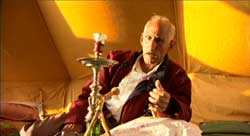 I fell into a routine
of
filming every day, all kinds of subjects. I filmed women in tents whose
houses had been bulldozed. Children dodging machine-gun fire on their
way home from school. Rock-throwing demonstrations. Patients suffering
in the hospitals from a gas attack. An old couple in Rafah whose small
villa was gradually being destroyed. A boy whose friend was blown up by
an Israeli booby-trapped device. Palestinians circumventing a roadblock
by driving along the beach. Assassinations carried out with Apache
helicopters. Funerals. Lots of funerals. It ran together in my camera
like a kaleidoscope of slow suffocation punctuated by moments of
extreme terror. All in all, I filmed more than 75 hours of material.
For every minute in the finished film there is an entire hour of
material that I had to leave out.
I fell into a routine
of
filming every day, all kinds of subjects. I filmed women in tents whose
houses had been bulldozed. Children dodging machine-gun fire on their
way home from school. Rock-throwing demonstrations. Patients suffering
in the hospitals from a gas attack. An old couple in Rafah whose small
villa was gradually being destroyed. A boy whose friend was blown up by
an Israeli booby-trapped device. Palestinians circumventing a roadblock
by driving along the beach. Assassinations carried out with Apache
helicopters. Funerals. Lots of funerals. It ran together in my camera
like a kaleidoscope of slow suffocation punctuated by moments of
extreme terror. All in all, I filmed more than 75 hours of material.
For every minute in the finished film there is an entire hour of
material that I had to leave out. 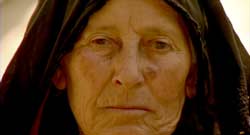 My idea of a good
documentary is a film that captures the most essential aspects of its
subject, a film that shows rather than tells. I wanted to make a film
that would convey not only the hard facts of life inside the Gaza
Strip, but also the emotions, sensations and driving desires of the
people I filmed. I made the film to fill a gap in our knowledge and a
blind spot in our thinking about this conflict, but more than anything
this film is an attempt to record the humanity of the people I met
there, the thing that is impossible to tell in words."
My idea of a good
documentary is a film that captures the most essential aspects of its
subject, a film that shows rather than tells. I wanted to make a film
that would convey not only the hard facts of life inside the Gaza
Strip, but also the emotions, sensations and driving desires of the
people I filmed. I made the film to fill a gap in our knowledge and a
blind spot in our thinking about this conflict, but more than anything
this film is an attempt to record the humanity of the people I met
there, the thing that is impossible to tell in words." -- Director / Producer, James Longley
Chronologie der Gewalt gegen Gaza
Belagerung von Gaza
Liste von Medienberichten zu Israel und Palästina
Gaza Strip, ein Dokumentarfilm
Medienanalyse
UN-Resolutionen
Palästina / Israel entzerrt
